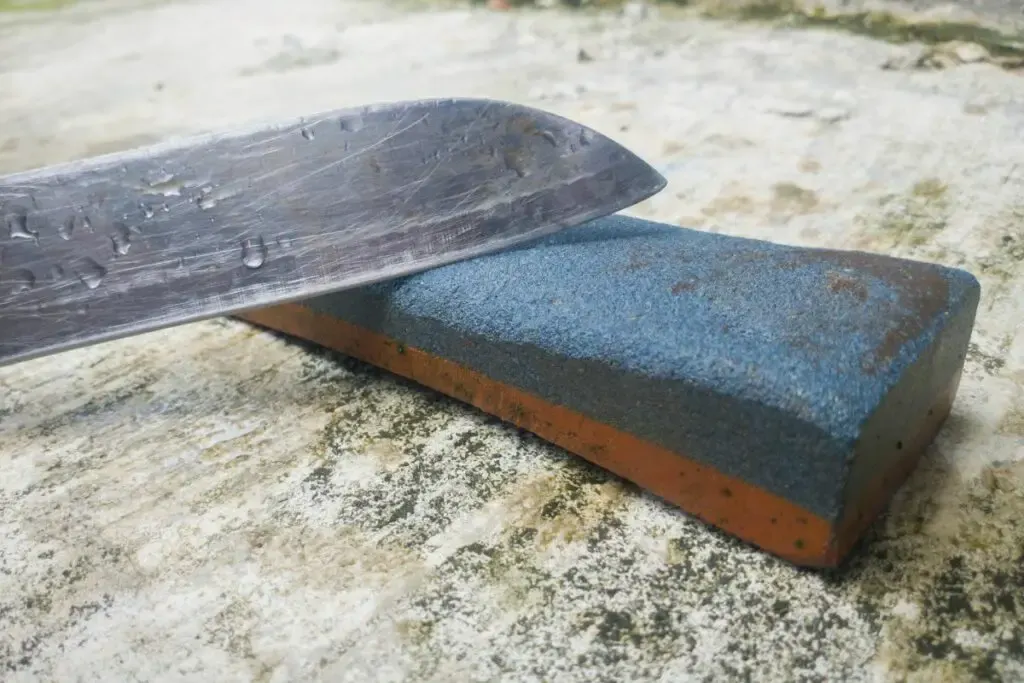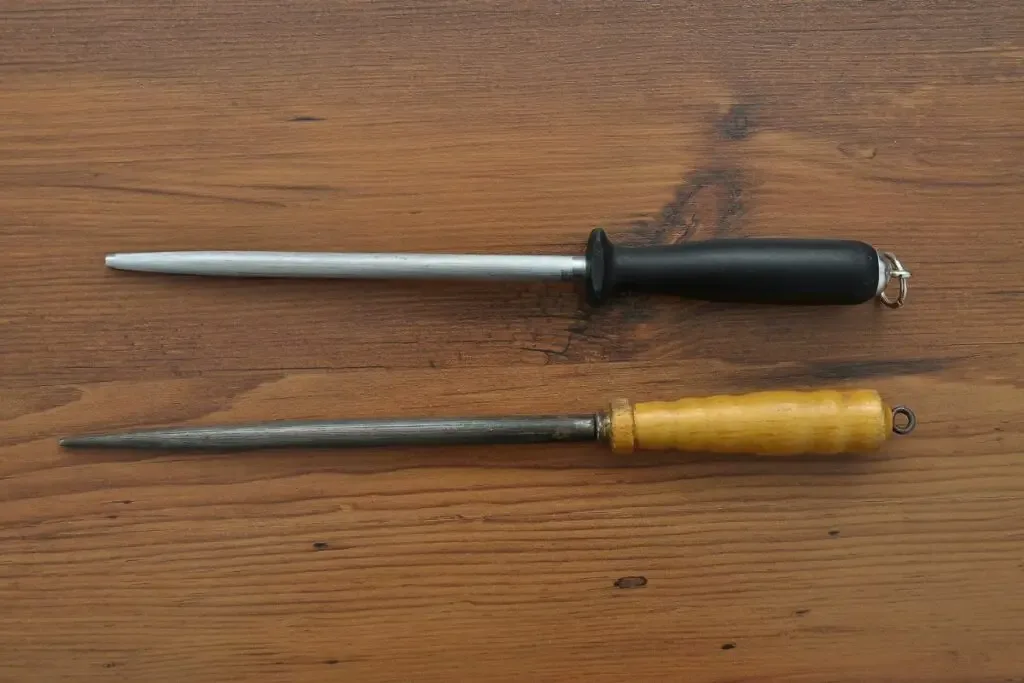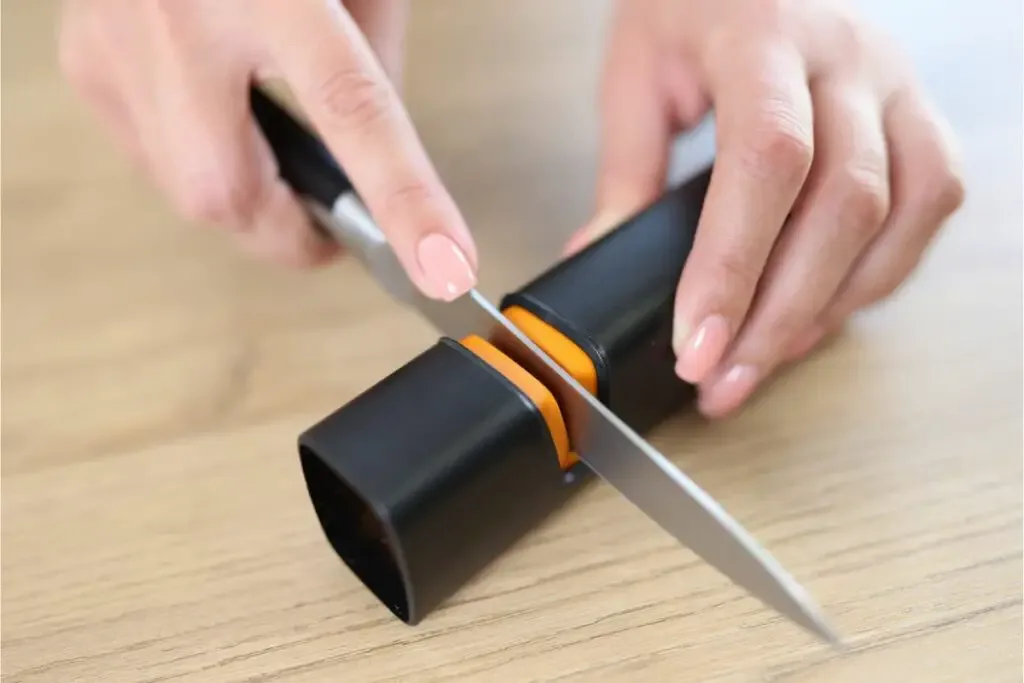As an Amazon Associate, we earn from qualifying purchases with no additional costs for you.
There are many styles and varieties of knife sharpeners available to the knife owner or knife maker. These can be in the form of stones, pull sharpeners, or honers such as a knife-steel. As a knife owner, you most probably already own such a sharpening device, and you may wonder how long these gadgets last. Do knife sharpeners wear out, and how do you know when they need replacing?
Knife sharpeners do wear out from repeated use. The abrasive material on the sharpener is worn away as the knife is drawn across the surface of the sharpening tool. The abrasive material is harder than the steel of the knife, so the abrasive is worn away at a slower rate than the knife blade.
Whatever the style of knife sharpener you use, the method of sharpening the knife generally relies on an abrasive of some sort to grind steel from the sharp edge to restore it to a good performance edge.
The action on the knife sharpener as it performs this task must have some consequence to the sharpening tool, and it must suffer wear and tear as a result. So do these tools wear out, and how do you know it is no longer putting a good edge on your knife and needs replacement?
If you are interested in checking out the best whetstones for your knives we recommend and use you can find them by clicking here (Amazon link).
Do Knife Sharpeners Wear Down And Become Ineffective?

Knife sharpeners are made from a number of different materials that have different levels of resistance to wear during the course of their use. Knife sharpeners are also made to sharpen knives with a different level of aggression or intensity, depending on the damage to the edge of the knife.
Some tools are intended to hone an already sharp knife that just needs to have the edge touched up, while others are aggressive enough to re-establish the edge on a very dull knife.
Due to a large number of different types of sharpeners, and the differences in their application, we will need to investigate each type separately to identify how they react to use and the level of wear they incur.
How Knife Sharpeners Are Affected During Sharpening
All knife sharpeners use an abrasive material to reshape the sharp edge of the knife being sharpened. We have all noticed the waste material that is produced when sharpening a knife.
This waste material is not only bits of steel that are being ground off the edge of the knife but also bits of the abrasive material from the sharpener.
This is most visible when using a whetstone when the swarf that accumulates during sharpening is very visible. You can also visually see this on v-shaped pull-through sharpeners if you sharpen the knife on a light-colored countertop.
You will see small flakes of material being ejected from the sharpener with each stroke of the blade through the sharpener.
This means that knife sharpeners do suffer a loss of material from their abrasive surface during the sharpening process.
Of course, the hardness of the abrasive material will determine how much wear is placed on the sharpener and how long the sharpener will last before needing to be replaced.
How Whetstones Wear Out

Whetstones, be they waterstones or oil stones, all wear out, and the wear in these sharpeners is the most obvious to the user than with other sharpeners.
Whetstones wear a little differently from other sharpening devices. A good whetstone should have a consistent grit throughout the stone. This means that as you wear away the surface of the stone, the layer beneath it will cut the same as the one that has been worn away.
Thus, a good quality whetstone will not lose its ability to sharpen the knife as it gets worn down. The problem with wear on a whetstone is when it wears unevenly because of the uneven pressure that the user places on different areas of the stone.
This results most frequently in the stone becoming bowed or hollowed out in the middle. This is, however, no reason to discard the stone.
The stone can be flattened out with special tools or with another stone of a coarser grit. Once it has been flattened, the whetstone will be useable again and will sharpen the knives to the same standard as it did when you first bought it.
If looked after and regularly flattened, a good whetstone can last six months to a year with heavy use, two to three years of moderate uses, and ten years or more with infrequent use.
TIP: One of the often discussed topics in the field of whetstones is the discussion of whether it is possible to leave a whetstone in water or not. Find out the answer in the article below:
Can You Leave A Whetstone In Water? All You Need To Know
How Diamond Stones Wear Out
Diamond stones are constructed a little differently from whetstones. Diamond stones normally have a rigid base plate to which the diamond grits are secured with an adhesive.
Diamonds stones are extremely durable, but they do suffer wear and tear as they are used to sharpen your knife.
A diamond stone needs to be used correctly to make it last longer. You do not need to use the same pressure on a diamond stone as you do on a whetstone. Excessive pressure will simply dislodge more of the diamond grit.
A good quality diamond stone can last for many years before it needs to be replaced. Occasional sharpening on a diamond stone, such as a few times a month, will put very little wear on the diamond grit, and the sharpener will last you decades before it needs to be replaced.
If your diamond stone is in daily use, you may need to replace it after two or three years of use. The way to tell when you need to replace your diamond stone is when it takes longer than before to put an edge on the knife.
You will also visually be able to see the stone becoming smooth in patches and losing its grittiness.
How Pull-through Sharpeners Wear Out
Pull-through style knife sharpeners are usually made with a carbide abrasive that does the sharpening on the blade of the knife. There are some varieties that use ceramic material to sharpen the edge.
Pull-through carbide knife sharpeners are not very popular among knife makers and owners of expensive knives. The feeling is that they remove too much material from a knife-edge, and the edge can also become jagged rather than sharp.
If you get a well made pull-through sharpener, they can be useful and have their place in the kitchen or workshop to do quick sharpening jobs and will put a useable edge on a knife or a tool, but they are not recommended for expensive knives or knives where you want a razor-sharp edge.
The carbide abrasive used in a pull-through style sharpener will wear out over time, but it can take a long time to wear down to the point of being unusable.
You will know that your carbide abrasive is worn out when the knife slips through the v-shaped groove with almost no resistance, and the edge no longer becomes sharp after two or three passes through the sharpener.
TIP: Another option for sharpening knives is to use leather. The use of leather is especially suitable in the final sharpening step. Check out the ultimate DIY guide on how to sharpen knives with leather in the article below:
How To Sharpen Knives With Leather: A DIY Guide
How Honing Steels Wear Out

Honing steels are used to touch up the edge of an already sharp knife and, as such, do not remove much material from the edge of the knife. Their function is more to re-align the sharp edge that has been folded over rather than to grind in a new edge.
Much less pressure is also used on the honing steel than on any of the other sharpening tools mentioned, which also reduced the wear that occurs on the honing steel itself.
Honing steels do remove small amounts of steel from the knife, and they do experience wear over time, but the wear is very slow, and as a result, honing steel can last ten years or more and still do a great job of re-aligning the knife’s edge.
When your honing steel begins to wear out, you will notice the grooves along the length of the steel beginning to flatten out and come close to the level of the steel in the valley of the grooves.
You will also notice that the honing steel will not make much of a difference to the sharpness of the blade.
TIP: Are you looking to buy a new whetstone? Check out our recommendations (we personally use the first three ones):
Our PRO choice whetstones combo (Amazon links):
- Fixing stone: Whetstone SHAPTON Ceramic KUROMAKU #320
- Sharpening stone: Suehiro CERAX soaking whetstone: Medium #1000
- Finishing stone: Whetstone SHAPTON Ceramic KUROMAKU #5000
Our budget choice (Amazon link): Sharp Pebble Extra Large Sharpening Stone Set
Knife Sharpener FAQs

To offer a complete overview of knife sharpeners and whetstones, we have included answers to some questions we frequently receive regarding the topic.
1. Do knife sharpeners wear out? Yes, knife sharpeners do wear out over time due to the abrasive material being worn away as the steel blade of the knife is drawn across the abrasive surface of the sharpener.
2. How can I tell if my knife sharpener is worn out? Signs of a worn-out sharpener vary by type. For example, whetstones may become uneven, diamond stones may lose their grittiness, and pull-through sharpeners may allow the knife to pass through with little resistance.
3. How long does a typical knife sharpener last? The lifespan of a knife sharpener depends on its type and frequency of use. A good whetstone can last from six months to over ten years, while a diamond stone can last for many years, even decades, with occasional use.
4. Do all types of knife sharpeners wear out the same way? No, different types of sharpeners wear out differently. For instance, whetstones wear out due to uneven pressure, while diamond stones wear out when the diamond grits are dislodged due to excessive pressure.
5. Are there any sharpeners that don’t wear out quickly? Honing steels, which are used to touch up the edge of an already sharp knife, tend to wear out very slowly and can last ten years or more with proper use.
6. Can a worn-out whetstone be fixed? Yes, a worn-out whetstone can be flattened out with special tools or with another stone of a coarser grit. Once flattened, the whetstone will be usable again, and sharpen knives to the same standard as when new.
7. Are pull-through sharpeners recommended for all types of knives? Pull-through sharpeners can be useful for quick sharpening jobs and can put a usable edge on a knife or a tool. However, they are not typically recommended for expensive knives or knives where a razor-sharp edge is desired, as they can remove too much material from the knife edge.
Conclusion
Knife sharpeners do wear out, but because of the material they are made from, it takes a long time for them to wear out to the point that they need to be replaced.
The quality of the sharpening device will also factor into the longevity of the abrasive. Always purchase the best quality knife sharpener that you can. It will not only be the best choice for your knife, but the sharpener will also last significantly longer.
TIP: Different knives often require different types of sharpeners. One of these types is pocket knives. Check out the best knife sharpeners for pocket knives in the article below:
The 4 Best Knife Sharpeners For Pocket Knives

